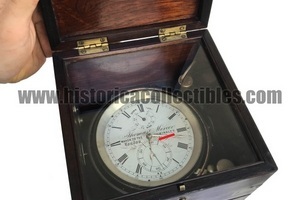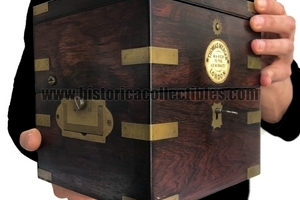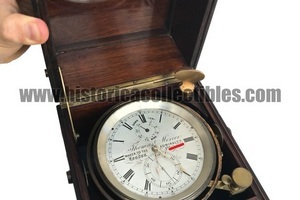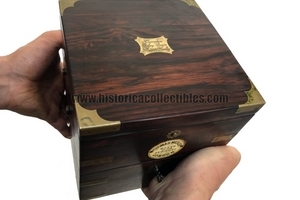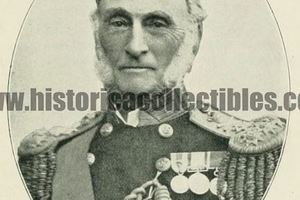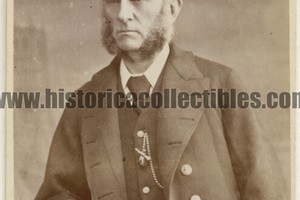Chronometer Thomas Mercer to Commodore Geoffrey Thomas Phipps Hornby, 1864
Chronometer (power reserve 56h), produced by Thomas Mercer in 1864 and belonged to Commodore (Captain) Geoffrey Thomas Phipps Hornby, who would shortly become Commander-in-Chief of the West Africa Squadron, Commander in Leader of the Flying Squadron and later Commander-in-Chief of the Canal Squadron. He continued his career rising to the rank of Commander-in-Chief of the Mediterranean Fleet, President of the Royal Naval College at Greenwich and finally Commander-in-Chief of the entire British Naval Fleet.
This chronometer appears to be one of the oldest timepieces currently known produced by Thomas Mercer, a company founded in 1858.
Geoffrey Thomas Phipps Hornby was promoted to the rank of Commodore in 1865 when this Chronometer was privately purchased by him, or given to him by some person close to him, for a sum of £20, from a Thomas Mercer dealer, located in Sunderland, named "Noton - Nautical Optician".
This information was provided by Dear Mrs. Coralie of Thomas Mercer.
Perfectly functional and excellently preserved, it is one of the very few surviving chronometers produced in the first decade by Thomas Mercer.
The chronometer is kept in its original case made with the very rare "Calamandra" or Coromandel wood, a heavy wood belonging to the ebony genus coming from south-east Asia, India and Sri Lanka, with an almost black color with hazelnut colored stripes. This wood was used so much until it became extinct and currently, no quantity is available for new work.
There are set and removable brass handles on the sides, in the "countryside" style, furthermore a bone plate placed on the front is engraved with a repetition of the manufacturer's details, while a brass plate set and engraved above the lid highlights the This Chronometer belongs to Commodore Geoffrey Phipps Hornby.
Perfectly working.
Geoffrey Phipps Hornby
Admiral of the Fleet Sir Geoffrey Thomas Phipps Hornby GCB (10 February 1825 – 3 March 1895) was a Royal Navy officer. As a junior officer, he saw action at the capture of Acre in November 1840 during the Egyptian–Ottoman War. As a captain he arrived at Vancouver Island with a naval brigade and found that a unit of American troops was about to take over the San Juan Islands in a dispute known as the Pig War: he used his powers of diplomacy to facilitate a peaceful handover of the islands to the United States.
Hornby went on to be Commander-in-Chief, West Africa Squadron, Commander-in-Chief of the Flying Squadron and then Commander-in-Chief, Channel Squadron. After that he became Commander-in-Chief, Mediterranean Fleet, President of the Royal Naval College, Greenwich and finally Commander-in-Chief, Portsmouth.
Early Career
Born the son of Admiral Sir Phipps Hornby and Sophia Maria Hornby (daughter of General John Burgoyne), Hornby was educated at Winwick Grammar School and Southwood's School in Plymouth and joined the Royal Navy in March 1837. He was appointed, as a first class volunteer, to the first-rate HMS Princess Charlotte, flagship of the Commander-in-Chief, Mediterranean Fleet and saw action at the capture of Acre in November 1840 during the Egyptian–Ottoman War. He transferred to the fourth-rate HMS Winchester, flagship of the Commander-in-Chief, Cape of Good Hope Station, in August 1842.
He went on to be mate in the sixth-rate HMS Cleopatra, in the West Africa Squadron, and took part on anti-slavery operations. Promoted to lieutenant on 15 June 1845, he became flag-lieutenant in the second-rate HMS Asia, flagship of his father, who was Commander-in-Chief, Pacific Station, in September 1847. He was promoted to commander on 12 January 1850 and to captain on 18 December 1852.
Hornby had no patron once the Aberdeen ministry came to power in December 1852 and instead cared for his father's estate at Lordington and played no part in the Crimean War. Following a change of government, Hornby became commanding officer of the frigate HMS Tribune on the Pacific Station in August 1858. When he arrived at Vancouver Island with a naval brigade, he found that a unit of American troops was about to take over the San Juan Islands in a dispute known as the Pig War. Hornby used his powers of diplomacy to facilitate a peaceful handover of the islands to the United States.
Hornby became commanding officer of the first-rate HMS Neptune in the Mediterranean Fleet in February 1861 and then became flag captain to the Commander-in-chief, Channel Squadron in the second rate HMS Edgar in May 1863. In January 1864 the squadron was instructed to shadow the ships of the Austro-Hungarian Navy on route to Prussia and to sink their ships if they bombarded Copenhagen as their answer to the Schleswig-Holstein Question.
Promoted to commodore, he became Commander-in-Chief, West Africa Squadron, with his broad pennant in the frigate HMS Bristol in September 1865. He condemned the independent rulers of West Africa for continuing to supply slaves when all civilised countries except Brazil had abolished slavery.
Senior Command
The frigate HMS Liverpool, Hornby's flagship as Commander-in-Chief of the Flying Squadron.
Promoted to rear admiral on 1 January 1869, Hornby became Commander-in-Chief of the Flying Squadron, with his flag in the frigate HMS Liverpool, in June 1869 and undertook a circumnavigation of the World to demonstrate that Royal Navy could reach any part of the globe. He went on to be Commander-in-Chief, Channel Squadron, with his flag in the armoured frigate HMS Minotaur, in September 1871 and in that capacity entertained President Ulysses S. Grant at Gibraltar.
Hornby became Second Naval Lord under the Second Disraeli ministry in December 1874 and was promoted to vice admiral on 1 January 1875. He went on to be Commander-in-Chief, Mediterranean Fleet, with his flag in the battleship HMS Alexandra, in January 1877. He forced his way through the Dardanelles, despite Turkish protests, in a display of British naval power intended to deter Russian aggression during the Russo-Turkish War. Sir John Fisher, who served under Hornby in the Mediterranean Fleet, wrote that he was 'the finest Admiral afloat since Nelson. There never lived a more noble character or a greater seaman. He was incomparable'.
The naval historian Sir William Clowes, who knew him well, wrote that '... he was a natural diplomatist, and an unrivalled tactician; and, to a singular independence and uprightness of character, he added a mastery of technical detail, and a familiarity with contemporary thought and progress that were unusual in those days among officers of his standing'. Hornby was appointed a Knight Commander of the Order of the Bath on 12 August 1878.
Promoted to full admiral on 15 June 1879, Hornby became President of the Royal Naval College, Greenwich in March 1881 and went on to be Commander-in-Chief, Portsmouth in November 1882. He was advanced to Knight Grand Cross of the Order of the Bath on 19 December 1885, appointed First and Principal Naval Aide-de-Camp to the Queen on 18 January 1886 and promoted to Admiral of the Fleet on 1 May 1888. He was appointed to the staff of the German emperor Wilhelm II during his visits to England in 1889 and 1890. He retired in February 1895 and died of influenza at Lordington House on 3 March 1895; his ashes were scattered at Compton Church.
Family
In 1853 Hornby married Emily Frances Coles (sister of Captain Cowper Coles), with whom he had three sons and two daughters. One of his sons, Edmund Phipps-Hornby, a major in the artillery, won the Victoria Cross in South Africa in 1900; another, Robert Hornby, became an admiral in the Royal Navy.
Thomas Mercer Chronometers is a British company specialising in the design and production of bespoke chronometers.
William Walker was born in 1783 and founded a dynasty of watchmakers in St. Helens, Merseyside. His grandson, Thomas Mercer was apprenticed to him. Thomas’s father, Richard Mercer, was a sailmaker, so Thomas had the horological and the nautical in his career ancestry.
The Shackleton Chronometer.
Thomas moved to Liverpool to continue working as a watchmaker in 1843, and thence to London in 1854, to buy a one-way ticket to the USA, in search of new and better prospects. Seeing a chronometer in the window of John Fletcher (chronometer makers), he changed his mind about the USA, asking for work and being hired on the spot. He then founded the eponymous firm Thomas Mercer Chronometers in Islington, London in 1858. This area, (including Clerkenwell and Covent Garden), was a hotbed of creativity and retailing in the chronometer sector. It was highly competitive – as well as the British names of Dent, Frodsham, Reid, Blackie, Johnson.
The British Horological Institute (BHI) was established in Clerkenwell in 1858, supposedly the first professional horological institute ever. Mercer was its honorary treasurer from 1875 to 1895, and “lectured there on the need to modernize the industry and to train young people”. Years later, his grandson would have to be trained in France (see below) owing to lack of a college in the UK.
TMC (Thomas Mercer Chronometers) remained in Clerkenwell until it moved to bigger premises in St. Albans in 1874.
Chronometers were ‘rated’ for accuracy at the annual trials in Greenwich – success was often lucratively rewarded with contracts from private and public sectors. Tom came second at the Greenwich Trials in 1881. The following year, his son Frank Mercer was born, who in later years won Greenwich first prize in 1911 with Mercer 8306. It was bought by Astronomer Royal Frank Dyson for the Greenwich Observatory. Thomas Mercer Chronometers sold many ‘white label’ pieces to middlemen, retailers who would put their own name on the dial of a chronometer made completely by TMC. Many of these were very successful at the Greenwich Trials, but the prizes did not go to TMC. Before judging an horological competition in Paris, Tom caught an infection and died there in 1900.

